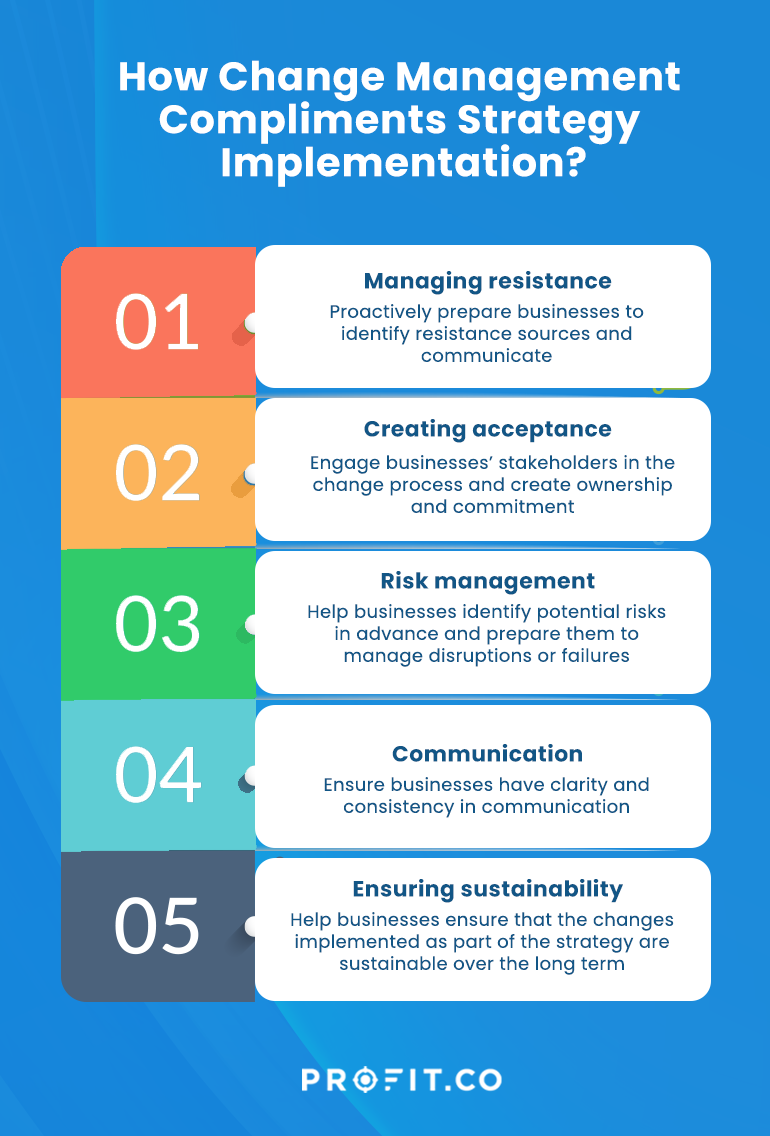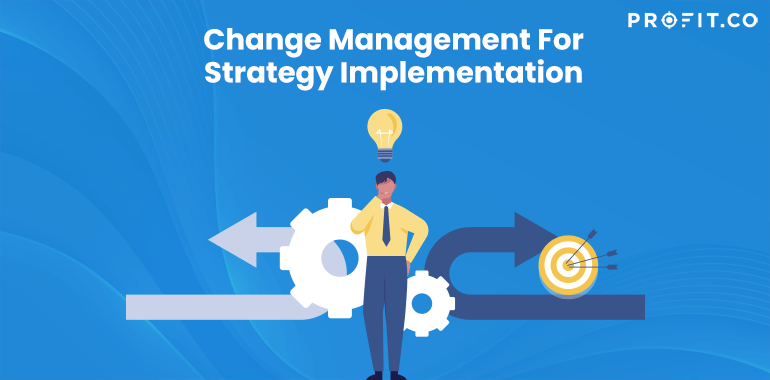Strategy implementation is essential for organizations to stay competitive and achieve their goals. A strategy is a plan, roadmap, and course of action created to achieve operational goals and business objectives. A strategy helps businesses identify their long-term goals and create a blueprint involving the necessary steps.
Strategy implementation is the process of following the strategic plan to execute all the activities and operations outlined in it, achieve all the milestones within the specified timelines, budget, and resources, and fulfill the objectives.
When an organization goes through such radical shifts, it can create resistance, confusion, and uncertainty among employees and stakeholders, which can even lead to the failure of the strategy. For instance, downsizing the workforce and restructuring the organization leads to a dip in morale and motivation levels, making it necessary to manage those changes carefully to achieve the objectives.
So it is crucial to have effective elements of successful change management to manage these changes and achieve business outcomes.
In this blog, we will explore the process and implications of change management in conjunction with strategy implementation.
Key Takeaways
- Change management is essential for smooth strategy implementation, as it helps organizations navigate challenges, minimize resistance, and maximize adoption.
- Change management involves a 4-step process: assessment, planning, implementation, and evaluation.
- Strategy implementation requires change management because it often leads to significant organizational structure, processes, systems, organizational culture, and personnel changes.
- There are four types of strategic change: continuous improvement, competitive counteraction, metamorphic transformation, and inventive disruption.
- Change management complements strategy implementation by managing resistance, creating acceptance and buy-in, risk management, communication, and ensuring sustainability.
What is Change Management?
Change management is the planning, executing, and monitoring a change to minimize resistance and maximize adoption. It involves organizing and controlling the activities that lead to the successful implementation of changes within an organization. Change management takes a structured approach to transition individuals, teams, and the entire organization from the current state to a desired condition.
Change management is indispensable because it helps organizations navigate the challenges in implementing a change. Through change management initiatives, organizations can minimize the resistance to change and ensure a smooth implementation of change and achievement of the desired outcomes. Organizational flexibility is crucial for effective change management as a flexible organization is responsive to changes and adapts quickly to new situations. It can easily adjust to new technology, regulations, or economic environments. OKR (Objectives and Key Results) is a goal-setting framework that helps organizations set ambitious objectives and over-achieve their goals by enabling teams to focus on the right priorities and measuring progress toward their objectives. It is highly effective in helping flexible organizations manage change with OKRs effectively. With OKR, organizations can define highly ambitious objectives and Specific, Measurable, Attainable, Relevant, and Time-bound (SMART) key results to achieve those objectives.
Our goals can only be reached through a vehicle of a plan. There is no other route to success.
Four Steps Of Change Management
For a successful implementation of change, it is important to follow the proper steps.
Change management involves the following four steps:
1. Assessment
The company management assesses the need for change, identifies the stakeholders affected by the change, and defines the scope of the change.
2. Planning
The planning phase involves developing a comprehensive action plan for implementing the change. It includes creating timelines and schedules for the change, resource allocation, budgeting, risk management, and communication strategies.
3. Implementation
Implementing a change involves:
- Following the action plan.
- Executing everything as per the plan.
- Completing the predetermined milestones as per the timeline and within the budget.
- Communicating the changes to stakeholders.
- Managing resistance to change.
4. Evaluation
During the evaluation phase, the change leaders measure the effectiveness of the change and make adjustments as needed to ensure that it is successful.
Bridge the Strategy Execution Gap with Profit.co
Four Key Change Management Implications For Strategy Implementation
Strategy implementation requires change management because implementing a new strategy causes significant changes to how a business operates.
Strategy implementation can lead to changes in the following areas:
1. Organizational structure
The organizational structure may change during strategy implementation due to various factors, such as the emergence of new business models or lack of results from the current management structure. For instance, when the technical design of a tech product needs to equally prioritize multiple areas of product development, such as industrial design, software and UI design, and electronic hardware design, then the company might opt for a matrix management structure where the three streams of product development may have their heads who need to manage their teams and produce a mutually complementing design to achieve the objectives of the product design. Splitting a single product design team into three is a major strategic decision. When implemented, it creates sweeping changes, requiring the creation of a new hierarchical structure, new departments, revised roles and responsibilities, reporting structures, etc.
2. Processes and systems
Implementing a new strategy will eventually lead to changes in the business processes, systems, and workflows. For instance, the business strategy of a customer-centric organization would involve constantly improving the processes and upgrading the systems and technologies related to customer support and user experience. Implementing the strategy would necessitate the business to integrate popular messaging apps into its customer relationship management system to cater to the customers in more ways and make it more convenient for them to contact customer support through different channels. It is a huge undertaking, and it involves massive changes. The company must set up business accounts in those apps, integrate those customer support channels into their existing system, consolidate data from various customer support channels and link them to the respective user profiles, train people to use multiple customer support channels, provide links on your website, make UI changes, send emailers to customers, and post about the new options on social media.
3. Organizational culture and mindset
Implementing a new strategy may cause changes in the organizational culture and mindset. For instance, Facebook was primarily a social media company and a messaging app maker. Their foray into VR hardware and metaverse shifted their focus from consumer software and social media platforms to enterprise virtual reality. They even rebranded the company as “Meta” to reflect the change in their organizational strategy. It leads to changing the vision of the company, acquiring new companies, recruiting employees with vastly different skill sets, restructuring the teams, and building new technologies.
4. Personnel
Implementing a new strategy may require changes to the organizational hierarchy and the personnel. It may necessitate hiring new employees with specific skills or retraining existing employees to adapt to new processes and systems. For instance, after the completion of a software project, a tech company may assign employees to new projects. Depending on the nature of the new project, the team structure, roles and responsibilities for the personnel, the skill sets required, and the project implementation strategy may vary, requiring existing employees to upskill and recruit new employees with different skill sets.
These changes can be drastic and significant for businesses, but they usually result in improved performance, better efficiency, and a more competitive business overall.
Change management for strategy implementation helps businesses by:
- Mitigating the risks posed by the changes and minimizing the impact while implementing a new strategy
- Achieving a smooth transition by adopting a structured approach to managing the people and processes involved
- Ensuring successful adoption, acceptance, and sustenance of the change over time
So, strategy implementation goes hand in hand with change management.
What Are The Four Different Types Of Strategic Change?
There are four different types of strategic change.
Strategy implementation leads to one of the following types of strategic change:
1. Continuous improvement
This type of strategic change involves making incremental improvements and updating existing processes, systems, or products. It is a gradual approach to change that focuses on optimizing what already exists. For instance, companies constantly assess the efficiency of every step in an assembly line to find any room for improvement or to identify the possibility of eliminating some steps to improve speed and efficiency.
2. Competitive counteraction
Competitive counteraction involves anticipating and responding to threats from the competition. It is a proactive approach to change that focuses on understanding the market, observing the competition, predicting their moves, and positioning the organization to compete effectively. Revising the pricing of the products just around the time of a new product launch from a competitor comes under competitive counteraction.
3. Metamorphic transformation
This type of strategic change involves completely transforming the organization to adapt to new market conditions or technologies. It is a bold approach to change that requires significant resources and a willingness to take risks. Closing all the physical retail stores and shifting the business into eCommerce can be classified as a metamorphic transformation.
4. Inventive disruption
Inventive disruption involves creating new markets or disrupting existing ones. It takes a disruptive approach to change. Restaurants that eliminate printed menus and enable customers to place orders by scanning a QR code on mobile devices change how restaurants get orders. It can be categorized as an inventive disruption. Additionally, creating a QR code for each dish on the menu can streamline the ordering process and enhance the dining experience for customers.
How Does Change Management Complement Strategy Implementation?
Change management helps to manage changes caused by strategy execution in the following ways.

1. Managing resistance
Top-level management plan business strategies with minimal/no participation from the employees. So whenever businesses implement new strategies, there is a fear of uncertainty among the employees regarding their work and also a fear of the change and its implications on them. It leads to opposition and resistance to the changes from the workforce. Change management helps businesses proactively prepare themselves to identify potential sources of resistance, build communication and trust among employees, and allay their fears. This preparedness to address resistance helps them explain the new strategy’s potential benefits and reassure the employees. It enables businesses to overcome or minimize the negative impact on the strategy implementation caused by the resistance by improving employee engagement.
For instance, when a company introduces a new performance management system that will enable managers to provide more frequent feedback and encourage the participation of the employees in ongoing workplace conversations, it can make employees feel more scrutinized and more frequently assessed by the managers. It will eventually lead to resistance to the change. The change management team can address this resistance by communicating the new system’s benefits, providing training to help employees adapt to the new process, and involving employees in the design and implementation of the new system.
2. Creating acceptance and buy-in
The success of strategy implementation lies in the widespread adoption of the new strategy, processes, and systems. Creating buy-in and acceptance among the stakeholders is one of the most crucial functions of change management. Change management helps businesses engage stakeholders in the change process and creates ownership and commitment to the new strategy.
For instance, when a company wants to change its product strategy and develop a new product line to compete better, it requires the approval of the management board and the investors to fund the product development. Change management engages the stakeholders by providing clarity on the new strategy, presenting them with data and insights, soliciting feedback on the new strategy, convincing them and involving them in the development of the new approach, and creating a sense of shared ownership and responsibility for the success of the new strategy.
3. Risk management
Strategy execution almost always has a few unforeseen or undesirable risks. Change management helps businesses identify potential risks in advance and prepares them to manage unexpected problems, reducing the likelihood of disruptions or failures.
For instance, when a manufacturing company wants to implement a new production process, it will require significant changes to the existing equipment and infrastructure. The change management team manages the risk of disruption in production by developing a detailed implementation plan that minimizes downtime, identifying potential equipment failures or bottlenecks, and creating contingency plans in case of unexpected problems.
4. Communication
Since strategy implementation impacts various stakeholders, communicating the changes with everyone involved is imperative. Change management ensures clarity and consistency in communication.
For instance, when a healthcare organization implements a new cloud-based medical records system, it will cause significant changes in how patient information is collected and stored. The change management team produces a comprehensive communication plan and ensures effective communication.
The communication plan includes the following:
- Regular updates to employees and patients.
- Training for employees on how to use the new system.
- Inviting feedback to ensure effective communication.
5. Ensuring sustainability
Implementing a new strategy should create a lasting impact. Change management can help businesses ensure that the changes implemented as part of the strategy are sustainable over the long term, reducing the likelihood of failure.
For instance, when a company implements Objectives and Key Results (OKRs), it not only requires training on how to use the OKR tools but also needs a complete change in the way employees set goals and achieve them. When implementing this new OKR Change Management Program, if the employees set easy-to-achieve goals that focus more on the activities than outcomes, then the change will not last. The change management team needs to ensure sustainability by creating a process for ongoing coaching and feedback, incorporating the new training into the company’s onboarding process, and regularly evaluating the effectiveness of training to ensure that it achieves desired outcomes. It also needs to foster a culture of aiming high when setting goals and targets, changing the way employees think and work.
FAQs
1. What is change management for strategy implementation?
Change management for strategy implementation is the process of planning, executing, and monitoring the changes caused by a new strategy.
2. What is the importance of change management in implementing strategy?
Change management helps businesses manage the risks posed by the changes caused by strategy implementation process and minimize the impact of a new strategy. It facilitates the smooth transition of people and processes and ensures the successful adoption, acceptance, and change sustenance.
3. What is the relationship between strategy implementation and change management?
Strategy implementation requires change management because implementing a new strategy causes significant changes to how a business operates.
Conclusion
Implementing change can be nerve-wracking for any organization. Utilizing the steps of change management and various strategies will guide your organization through any uncertainty. By creating a plan for change and following the procedure in place, you will have solutions for any challenges that arise. Strategy implementation will help your business thrive, and change management will assist you with a smooth and successful implementation process.

